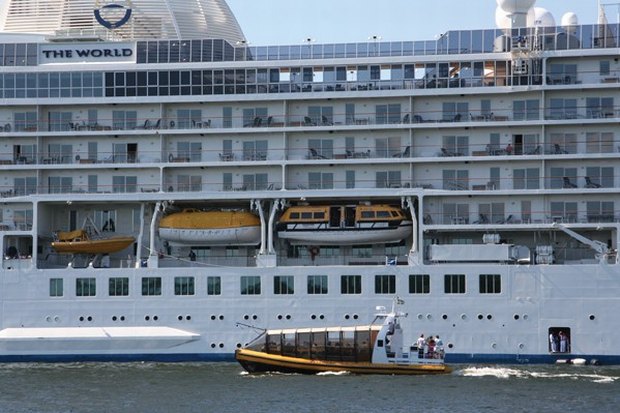
One alternative for a house abroad could be a flat on the cruiser The World. 200 m2, that is 3 balcony-units as show above, cost approximately 6 million US-dollars plus an annual fee of around 400 000 US-dollars. The ship takes you around most of the world and you decide for yourself whether you will live there permanently or only part-time. Photo: Odd Iglebaek
Considering further the notion of house ownership abroad, one large group of people is often forgotten, namely, that of immigrants who now own new homes in their home country. Some twenty years ago, on a visit to the countryside in southern Serbia during a period where growing labour unrest in Yugoslavia was being reported, I was invited to stay in a house where the owners were visiting only temporarily. Usually they lived and worked in the then West Germany. It was a new-built large house with all the modern facilities – their secondary home. They did not however use it very much and in fact often spent their holidays elsewhere.
Some year's later immigrants from Turkey, now living in Rinkeby on the outskirts of Stockholm, provided more details: – Yes, we have all used our savings to build modern houses in Anatolia, but our children do not want to go there. If they travel to Turkey, they want to go to the tourist-resorts on the coast. That is where all the fun is!
Driving through the countryside of Pakistan's Northwest Frontier Province in many places you will see new houses built in the traditional 'fortified' style, but looking rather expensive, particularly in areas known for emigration (or smuggling). Even though some members of the extended family live in the house ownership in reality remains with families in Northern Europe.
Or another example: Go to Melbourne in Australia and you will still find many families who own houses, or land, on the Greek island of Qitira between Crete and the Peloponnesus. Even the coast of war-torn Southern Lebanon, and home of Hezbollah, has for decades seen a building-boom related to the construction of holiday flats. Many owned by expatriates living permanently in Canada or the United States.
And of course there is Southern Spain; the Costa del Sol, if present trends continue, in a few years there will be holiday resorts for hundreds of kilometres, more or less continuously along the coast. The flats will be owned, in the main, by Northern Europeans: The British, the Germans, the Nordics and probably more and more Russians.
The Norwegian Prognosesenteret, a commercial market-trends institute, has for some years tried to follow Norwegian developments: – Our findings are based on interviews and we think that they are relatively accurate, explains chief economist Kjell Senneset. He notes that they estimate the number of Norwegian families at present buying holiday-homes abroad has reached 9000 – 10 000 per year. On average they spend more than 100 000 € per house.
Spain remains the most popular and approximately one third go there. France, Italy, Greece and Portugal are now also popular. Sweden is number two with more than 2000 houses each year. The latest developments include Turkey, Thailand, Brazil, South Africa and Bulgaria, but here the numbers are relatively small.
For Sweden similar estimates seem to be lacking. This is also the case for Iceland. As regards Finland there is very little material. However, the magazine Arvopaperi no 6/2004, estimated that the country has a total of 60 000 time share apartments, of which 12 000 are abroad. The most popular time share resorts abroad are in Tenerife and continental Spain.
For some years the ski-lodge market has been booming in Finnish Lapland. Traditionally, Finns have bought ski lodges, but now Norwegians are also buying ski-lodges in Kilpisjärvi. According to Helsingin Sanomat (11.02.2007) this has contributed to raising the price of some properties to as much as 300 000 €.
A similar development is taking place by Lake Saimen in south-east Finland. The area has become particularly popular among the nouveau riche of St. Petersburg. Again prices here are rising dramatically and have in one year alone increased from 50 000 to 60 000 € just for the plot of land. According to the Swedish newspaper Dagens Nyheter (17.07.2007) the local politician Suna Kymäläinen has initiated a protest movement against what she calls 'the Russian invasion'.
Denmark, on the other hand, has for many years had laws against foreigners buying summer-houses in the country. The official argument has been that the country has a very short coastline compared to the number of its citizens. This has led Danish news-service 24Timer to compare the coastline of Denmark with countries where some of the key Danish politicians have bought secondary homes. There findings are presented below:
Many Danes living in the densely populated island of Zealand (Sjælland), which include Copenhagen, have in later years been buying land and houses in southern Sweden. According to Berlingske Tidende (28.03.07) The Danish tax authorities have registered 5 500 such ownerships: - We think that is the majority, states Hans Kurt Larsen from Skat, the Danish tax authorities. In 2003 the same authorities registered 6 172 persons living in Denmark paying taxes for properties abroad. France was not included in this overview.

Click to view larger image.
By Odd Iglebaek